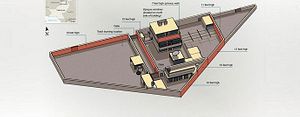On Wednesday, the U.S. Central Intelligence Agency (CIA), at the direction of Mike Pompeo, the Agency’s director, released 321 gigabytes of images, audio, text, and video gather at Al Qaeda leader Osama Bin Laden’s compound in Abbottabad, Pakistan. The data was acquired by U.S. forces in 2011 following a dramatic raid on the compound that resulted in Bin Laden’s death.
Wednesday’s release is the largest yet from Bin Laden’s files despite some limited releases of books and documents that were in Bin Laden’s possession by the Obama administration. The total release contains nearly 470,000 files, according to the CIA. Readers can download the files here—do take heed of the disclaimer, though, that the files have not been thoroughly scrubbed for malware and may contain disturbing content.
It will take open source researcher months—perhaps years—to uncover every last bit of newsworthy information from this newly released trove. Shortly after release, social media users—including this author—perused the file indices made available by the CIA for any particularly notable file names.
The results were predictably—and somewhat unpredictably—eclectic. Bin Laden possessed everything from manuals on manufacturing explosives to operational documents for civil aviator interception in the United States to Tom & Jerry cartoons, crocheting instructional videos, and even the well-known viral YouTube hit ‘Charlie Bit My Finger.’ The variety may seem odd until one recalls that the compound where Bin Laden resided was also home to nearly 30 more people, some of whom were young children that may take an interest in the lovable cat-and-mouse antics of Tom & Jerry (Bin Laden, in hiding for more than a decade, may too have enjoyed the show.)
What’s fascinating about the release is that the CIA chose to make some of the documents selectively available to the Foundation for the Defense of Democracies (FDD), a Washington, D.C., based think tank whose publication, the Long War Journal, had a short post ready to go upon release to provide some early context. The Long War Journal‘s analysis notably highlighted what the newly released information said about Al Qaeda’s relationship with Iran under Bin Laden’s leadership.
Bill Roggio and Thomas Joscelyn, the authors of that analysis, note that some of the information found in a newly released document supports the long-standing narrative of general acrimony about Al Qaeda and Iran. They do go on, however, to highlight that Bin Laden had described Iran as Al Qaeda’s “main artery for funds, personnel, and communication.” Political motivations for this release aside, no doubt the documents to establish Al Qaeda’s thinking on its complicated, but convenient relationship with individuals and entities in Iran.
For D.C. outsiders, FDD isn’t just any think tank these days. It’s at the center of the Iran policy conversation in Washington and was an important source of motivation for the Trump administration’s decision to refuse to certify Iran’s compliance with the 2015 Joint Comprehensive Plan of Action (JCPOA) as required by the Iran Nuclear Agreement Review Act (INARA).
More broadly, several voices within FDD openly have advocated for regime change in Iran. What’s more, weeks before the release of the new Bin Laden documents, Pompeo himself spoke at FDD on Iran and other matters. (Find the transcript of that talk here, where Pompeo is asked very specifically about “Iranian-Al Qaeda links.” He even announces that the Abbottabad release was around the corner.)
This context makes what would otherwise be a welcome act of government transparency somewhat appear less forthright and in service of the White House’s now-clear agenda to undermine the JCPOA and potentially pave a path toward conflict with Iran. Regime change rationales come in many shapes and sizes when it comes to Iran, with advocates pointing to the country’s poor human rights record, support for anti-Israel groups in the Middle East, and openly anti-U.S. rhetoric. Now add possible links to Al Qaeda to that list, but do take a look at the evidence yourself. After all, it’s all out there now.

































